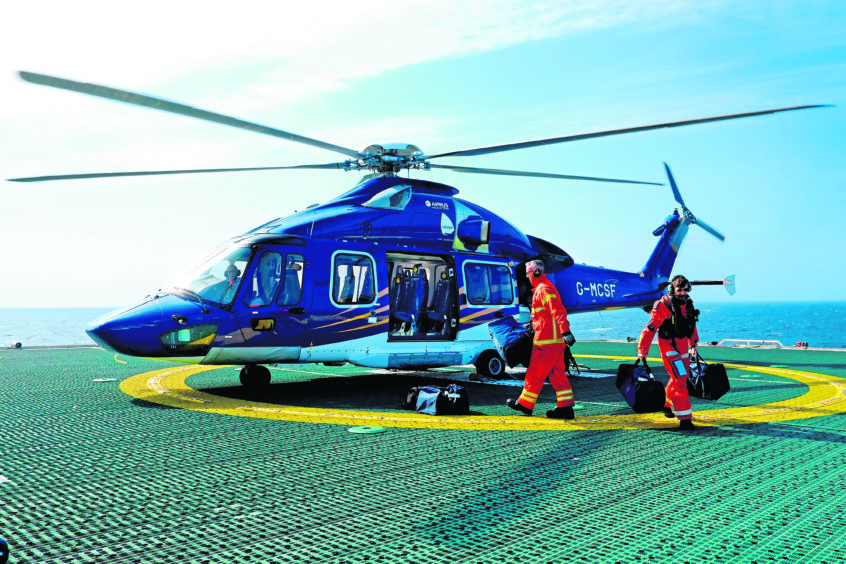
With North Sea helicopter safety in the spotlight, there will doubtless be many offshore workers once again spooked by having to commute to their places of work using a mode of transport that they would not ordinarily choose.
Statistically, rotary wing aircraft are not as safe as the ordinary fixed wing variety; or at least that’s what we’re given to understand.
The fatal accident rate for North Sea helicopters is around one per 250,000 hours versus around one per 10 million hours for commercial airliners.
But it is unrealistic to compare them.
They are quite different and in effect occupy two different worlds.
Of course, when an airliner goes down, the number of fatalities will invariably be huge when compared to a helicopter that ditches in the North Sea.
And, in the grand scheme of things a downed airliner has the potential to saturate headlines globally, as has happened in recent times with the Boeing 737 C-Max, where more than 400 pilots are now pursuing a class action against Boeing.
Following a string of North Sea incidents, including the 2013 ditching of a Super Puma off Shetland, the UK Civil Aviation Authority in February 2014 published a safety review of offshore helicopter operations.
The evidence presented in the review showed that just over half of accidents in which offshore helicopters impacted the sea between 1976 and 2012 in the UK were potentially survivable.
However, these accidents led to 38 fatalities.
The 2016 CAP 1243 progress report highlighted several areas where significant progress had been made in improving the protection of passengers in the event of an accident.
When the Boeing 737 Max returns to the skies, many passengers will seek to avoid it, according to a Twitter poll conducted last month.
Some 55% of those polled said they would not be happy to fly on it.
Indeed one individual said the Max would probably become one of the safest passenger aircraft that ever flew, once Boeing has sorted out the flight management sensor-related problems of this latest variant of the hugely successful Boeing 737.
Your average punter gets to choose which plane and with which airline to fly.
An offshore worker does not get that choice, though such was the collective antipathy displayed towards Airbus’s Super Puma and especially the H225LP and AS332L2 derivative after several tragedies that these aircraft have effectively been taken out of the picture, despite being cleared for service by the UK and Norwegian CAAs two years ago, subject to various modifications.
The Sikorsky S-92 has become the heavy, tough chopper for the long North Sea commute, making up about half the UK North Sea fleet.
Of the slightly smaller aircraft which make up the fleet, the Airbus H175 “super-medium” is a prime offering.
It first flew around 2008 and entered North Sea service in 2014 with Belgian operator NHV.
It is four tonnes lighter than the H225 and carries 18 passengers versus 19 for its heftier cousin.
At this time, eight or so of the 70 helicopters active in the North Sea are H175s, so a relatively small number.
Given how jittery North Sea workers are about their offshore commute; that another Airbus product appears to have an integrity problem is surely worrying. Perhaps terrifying.
Judging by photographs doing the rounds, the H175 problem could be bigger than anyone is currently prepared to admit.
The fault was spotted during a routine safety check on the “horizontal stabiliser” of an H175 aircraft operated by Babcock.
The class has not been grounded by aviation authorities and Airbus sent out service bulletins requiring inspections and imposing a maximum speed limit of 80mph.
One cannot over-emphasise the need to get to the bottom of the problem detected on this modern, highly advanced design whose safety record thus far appears to have been good.
Airbus knows only too well that no stone should be left unturned.
Meanwhile, a fatal accident inquiry into the 2013 Super Puma ditching off Shetland has belatedly been ordered by the Crown Office six years after the crash and more than three since the UK Air Accidents Investigation Branch published its findings.
In this regard, the tardiness of getting around to announcing the intent to hold an FAI has been roundly slated, and rightly so.
The 14 survivors and the next of kin of the four who perished need closure.
But, six years on, that is only now within reach, though highly dependent on when the inquiry starts, how long it runs for and how long it takes for the deliberations to translate into something concrete.
Whilst the industry will have largely learned and acted on the outcomes of the AAIB’s inquiry, which basically concluded that pilot error was responsible for the crash after failing to notice the aircraft’s descending airspeed.
It would come as no surprise if the FAI uncovers further detail that might also result in a tightening up of management in the cockpit.
However, it is shocking that the inquiry venue has not yet been selected.
And it’s a pity the start date remains vague.
Jake Molloy, regional organiser of the RMT Union, said the FAI system is “broken”.
He also feels that blaming a “single pilot” (there were two in the cockpit) for the accident was “wrong”.
That’s too easy, too Never-never Land.
Recommended for you
